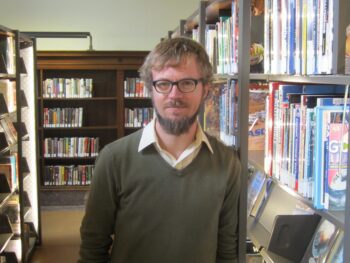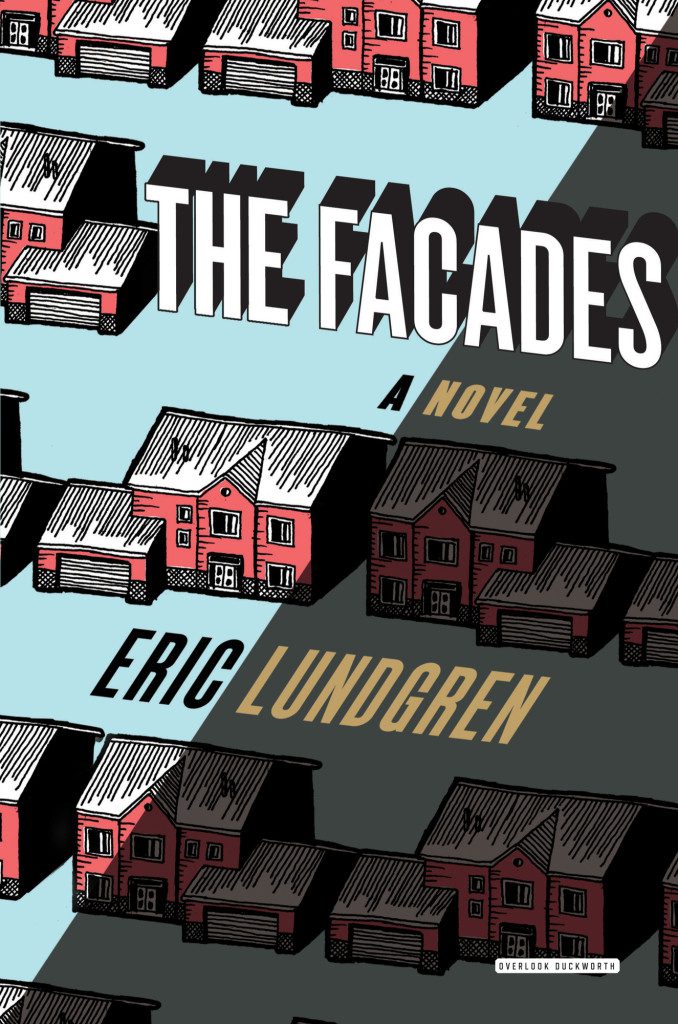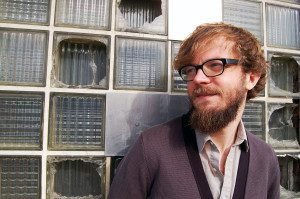
Eric Lundgren’s layered and exciting debut novel, The Facades, has invited a lot of comparisons. Jon Michaud described it as one of the “bastard offspring of Dashiell Hammett and Jorge Luis Borges,” while Jason Diamond said it draws comparisons to “David Lynch and Haruki Murakami.” Laura Miller called it one of the detective novels “influenced as much by Kafka as they are by Chandler” that can be read “as a Paul Auster-ish metanoir or as a travelogue of the sort of surreal city described in Italo Calvino’s ravishing postmodern masterpiece ‘Invisible Cities.’”
Amazingly, The Facades does contain elements of all these writers and more, while still feeling original and unique. The numerous literary allusions and homages mirror the multifaceted story, which involves—among other things—gun-toting revolutionary librarians, a lonely man’s search for his missing opera star wife, a shopping mall designed as a labyrinth, and a snobbish assisted-living home. The real subject of the novel is the setting: a sprawling yet crumbling metropolis that is one-part forgotten Midwest metropolis, one-part Calvinoesque imaginary city (and an epigraph to the novel lets us know that the city was indeed named after one of Calvino’s Invisible Cities.)
I corresponded with Eric Lundgren over e-mail, where we discussed inducing literary vertigo, film noir, and the Mall of America.
***
The Rumpus: The Facades has an epigraph from Italo Calvino’s Invisible Cities about a city named Trude, the same name as the city your novel is set in. One of the central figures is a bitter Austrian architect named Klaus Bernhard, clearly inspired by the great Austrian writer Thomas Bernhard. Many writers in the early stages of their careers seem to feel the need to hide their influences, being told to develop their own singular voice. What made you decide to name your influences in this way?
Eric Lundgren: My stuff’s always been pretty allusive. I read much more than I write. And—I imagine this holds true for most writers—my work is, among other things, an attempt to enter and comment upon the tradition. It’s a response. It didn’t come out of nowhere. Hiding your influences feels really unnatural to me, like walking outside and pretending trees don’t exist. I haven’t taught a fiction class for a while, but if I get the chance again, I think I’d have students do a lot more imitation. Writing that’s not aware of its influences may feel blazingly original, but more often it’s blandly, unconsciously imitative.
Rumpus: I’m with you; I want my work to be in conversation with the writers I love. I know authors who claim to never read other writers while writing, which makes no sense to me. However, there are a few authors I love whose styles are so infectious that I have to be careful not to be too imitative. One of those is definitely Thomas Bernhard. Do you have any writers you have to be careful around?
Lundgren: Yes, Bernhard is kryptonite for me as well. He has a particular sound, and there’s a real temptation to ape it, on a superficial level, with the repetition, the recursive layering of narrators, but his actual style is much more subtle and modulated than it appears. Bernhard would be a good subject for an imitation exercise. I would say David Foster Wallace is another. There’s something so alluring about that slangy-yet-erudite voice he developed, and it’s so pleasurable to let go and write a few pages in that vein; however, in my case at least, that’s a recipe for ending up with a handful of subpar stuff. I have to watch out, because I’m definitely prone to adopting the form of my verbal environment, like one of those minor forest creatures.
 Rumpus: In addition to Bernhard and Calvino, the novel is peppered with references to other great European writers like Robert Walser, Thomas Mann, and Ludwig Wittgenstein. You can see the influence of those writers in your work, but The Facades is also distinctly American in many ways. What American elements, whether authors, monuments, or fast food chains, influenced the book?
Rumpus: In addition to Bernhard and Calvino, the novel is peppered with references to other great European writers like Robert Walser, Thomas Mann, and Ludwig Wittgenstein. You can see the influence of those writers in your work, but The Facades is also distinctly American in many ways. What American elements, whether authors, monuments, or fast food chains, influenced the book?
Lundgren: One influence some readers might not recognize is J.F. Powers, the mid-century Catholic writer (and fellow Minnesotan). I paid homage to him by writing a scene in which a character gets hit in the head by a golf ball—this also happens in Powers’s novel Morte d’Urban, which beat out Pale Fire for the National Book Award in 1963. I could point to a ton of other American writers. Kathryn Davis, my professor at Wash U, has been writing this kind of shapeshifting, multilayered novel for a while. The idea of a labyrinthine shopping mall was inspired by an experience I had as a teenager getting high and wandering around the Mall of America. As for fast food, the primary influence would probably be Sonic, which is by my house.
Rumpus: Is there something about the Midwest that feels particularly ripe for a crumbling and labyrinthian city like Trude?
Lundgren: I’m somewhat reluctant to generalize about the Midwest, even though I’ve conflated a lot of different Midwestern places in the novel. St. Louis, where I’ve been for the past nine years, was huge in terms of the physical landscape and the emotional weather of the novel. It is a hauntingly beautiful place with a tangible sense of history. At the same time, there are times when the city seems to say, “Whatever you try to do is going to fail, like I did.” People are adapting and renovating and trying to make things work here, but in the end, it may not be enough. I’m being quite St. Louisan by saying that. In St. Louis I may have found the perfect external match for my own low-level melancholy. Similarly, in the novel, Sven Norberg and his environment have melded to an unhealthy, irreversible extent.
Rumpus: One of the things I really admire about the novel is that it feels like a collection of separate stories—Sven’s search for his missing opera singer wife, the standoff between the mayor and the shotgun wielding librarians, the history of Bernhard’s architecture, the son Kyle’s religious conversion, etc.—that could each be expanded into novels. Yet these threads are all held together by the spell of the prose, and as the novel moves on, the stories intersect in surprising ways. How intentional was this multifaceted story approach? Did it come about through the writing process?
Lundgren: That’s a great observation. Formally, I was sort of trained to think in terms of the short story, because I came up through these academic writing programs. But there was always something unsatisfying about that form to me. In a bad kind of short story, all the signs point in one direction. With several narrative threads, you can keep the reader off-balance, which is a sensation I crave as a reader. I really like the effect of storylines jutting up against each other in unexpected ways—the Pontius Pilate story against the fantastic, modern-day Moscow stuff in The Master and Margarita, for example. I tried to use the atmosphere of Trude and Norberg’s narrative voice to give it all a consistency, but I also hope this narrative structure creates a certain vertigo. The writing process was literally experimental in that it involved a lot of trial and error. And though it was really hard to get it right, because there wasn’t a preexisting model for what I was doing, I was also surprising myself along the way, and I hope the sense of surprise translates to readers.
Rumpus: Vertigo is a great word for it. I read you say in another interview that you whittled the book down from a much longer manuscript. Can you talk about how editing played into creating that sense of vertigo?
Lundgren: Yeah, there was a lot of more conventional connective stuff in the earlier drafts. The problem with doing a long narrative like this is that you raise all these questions that have to be resolved somehow, or at least most readers feel that way. And addressing these narrative questions can become a kind of drudgery that results in drudgery for the reader. I tried to vacuum out as much of that stuff as I could. I didn’t want there to be any filler in the novel. Every chapter that’s in there is in there because it delights me in some way. But some readers have missed the more expository pages. My goal was to create something that fits together intuitively, and I made a lot of editorial judgments based on the amount of pleasure I’d experience reading a certain passage. It was that more than a master plan. Fortunately, later in the game, I had a real editor who took a more systematic approach to these things.
Rumpus: On some level, The Facades is a detective story. Some of my favorite parts are the interactions between the two detectives and Sven. Did you read a lot of detective or mystery novels growing up?
Lundgren: Not especially. Noir cinema was probably the greater influence on these scenes, although I’ve enjoyed reading Chandler and Hammett, and I love Patricia Highsmith’s Ripley series. Generally I love the atmosphere and the stray details of noir. I’m pretty obsessed with Double Indemnity and Sunset Boulevard, Billy Wilder’s noir movies, though I guess they have a touch of Gothic. The details in those movies are so perfect—Barbara Stanwyck’s blonde wig! Settings and characters that would be overlooked in other kinds of fiction become these loci of intense observation. It’s an almost fetishistic genre. I’m fascinated by marginal characters who seem implicated in the rot of their surroundings. But it’s mostly the peripheral stuff I love in noir. When the plot machinery kicks in I tend to zone out—unless it’s being done by a really elegant plotter like Highsmith.
Rumpus: You have an interesting story about the cover art for the book. Can you tell it here?
Lundgren: My editor at Overlook discovered a German graphic designer named Jeffrey Postma. He’s clearly somewhat obsessed with Calvino’s Invisible Cities—he’s illustrated many of the cities, some of them multiple ways—and we both were instantly attracted to his illustration of Trude. The division of light and shadow in the piece, as well as the red houses, which evoked the red brick buildings of St. Louis, seemed to fit the book perfectly. When we contacted him, he was delighted. That’s the kind of unexpected collaboration I love.
Rumpus: One of the detectives, the Oracle, tells the narrator, Sven Norberg, “We find it profitable to treat mistakes as buried intentions.” Do mistakes—typos, confusions, misheard statements, etc.—play a role in your writing process?
Lundgren: I tried to open a space for that kind of language play in the novel. Most of the time I’m a very controlled, anal writer, moving punctuation marks around. I think it was Powers who said if he changed a comma to a semicolon, that was a good morning’s work. But I am actively trying to counter these Swedish-Lutheran parts of my personality. I want accident and surprise (i.e. life) in my writing. And there are parts of the novel, such as the acrostics and the chapter based on a Scrabble game, where I’m allowing words to take over purely for their formal qualities. This isn’t the same as a mistake but it’s similar in that you’re not in total control of what the form produces. It’s the same paradox the Oulipans found in formal structures, where you’re both tightly restricted and weirdly free. That’s part of what makes the wild flights of Invisible Cities work: there’s a rigorous underlying structure there. But I’d like to include more errors in my work. I should let myself mess up a lot more than I do currently.
Rumpus: I love the idea of trying to include more errors in a work! It reminds me of the Bolano quote, from 2666, where a character disdains people who prefer small “perfect exercises of the great master” instead of “the great, imperfect, torrential works, books that blaze paths into the unknown.” Aren’t most great works a little messy?
 Lundgren: Yes, and it’s great that 2666 says that, making an argument for itself. Writing a passage like “The Part About the Killings” earns you a wide berth, and there is some bad writing in 2666, but who cares? I think James Wood said that a certain kind of ambitious novel produces its own antibodies. For me, I think it’s about staging a contest within yourself, allowing both the imperfect, torrential, blazing part to make wild and impertinent claims, then allowing the stingy and skeptical part to take the floor and cross-examine. I struggle over utterance and I want the books to be surrounded by silence and haunted by what’s been left out of them. There’s been a loss of self-scrutiny among writers these past few years. Not that there hasn’t always been plenty of shoddy writing, but self-publishing and e-books add to that danger. It’s not so much about gatekeepers as forcing yourself to slow down. Self-interrogation. I think most writing I like has a profoundly masochistic element.
Lundgren: Yes, and it’s great that 2666 says that, making an argument for itself. Writing a passage like “The Part About the Killings” earns you a wide berth, and there is some bad writing in 2666, but who cares? I think James Wood said that a certain kind of ambitious novel produces its own antibodies. For me, I think it’s about staging a contest within yourself, allowing both the imperfect, torrential, blazing part to make wild and impertinent claims, then allowing the stingy and skeptical part to take the floor and cross-examine. I struggle over utterance and I want the books to be surrounded by silence and haunted by what’s been left out of them. There’s been a loss of self-scrutiny among writers these past few years. Not that there hasn’t always been plenty of shoddy writing, but self-publishing and e-books add to that danger. It’s not so much about gatekeepers as forcing yourself to slow down. Self-interrogation. I think most writing I like has a profoundly masochistic element.
Rumpus: The bitter architect, Bernhard, builds a labyrinthian shopping mall. At the groundbreaking ceremony, he mutters, “There is a solution to the labyrinth.” Is there a solution to the labyrinth of The Facades?
Lundgren: Well, the funny part is that Bernhard’s labyrinth fools everyone; you can even buy a t-shirt with the labyrinth design on it and the slogan TRUDE: WE TRIED. So the possibility that it’s solvable is a large part of the appeal; it is a commercial selling point, if you will. People like to read things as a puzzle, and part of what storytellers do is create a maze for readers to get lost in, yet at the same time there has to be a defined way in, a defined way out. Is there a solution to The Facades? I am interested to hear about people’s experiences of reading it. I don’t think there’s a right or wrong way to do so. It was not intended to be a book in which all the questions are fully and neatly answered at the end, but I also didn’t want to intentionally stymie or mock the reader’s curiosity in any way. I answered all the questions of the narrative as well as I could. There were attempts to write a more conventional ending to the novel, but they really felt false and tacked on—I got rid of them.
Rumpus: What are you working on now?
Lundgren: A campus horror novel that may owe more to Poe and Shirley Jackson than Calvino or Bernhard. The current plan is to do a trilogy set in the Midwest, including this one as the “mystery” novel, then a horror novel, and a romance novel (all very idiosyncratically defined). In a few more years I’ll be forty, and maybe by then I’ll be capable of writing about love in a present tense, non-tragic way. It’s a hard thing to do when you’re still young.
***
Featured image of Eric Lundgren © by Jason Sutterfield.
Second image of Eric Lundgren © by Gena Brady.




